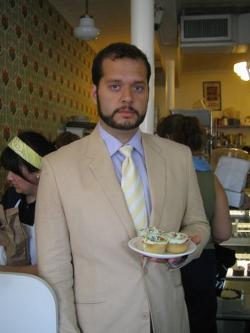60 Degrees of Separation
The Arctic is North America's biggest beat in terms of land mass. Veteran reporter David Staples describes what it's like to work as a foreign correspondent without ever leaving Canada
If you try to communicate with someone on the other side of a busy street, you can shout all you want, but something gets lost in the translation. This is what it?s like covering the Arctic from a southern city, but it?s the way most major Canadian news organizations do the job. The sometimes-strained nature of the reporting hit me hard earlier this winter when Northwest Territories Premier Don Morin resigned after a scathing report on his questionable political and business practices was released by conflict of interest commissioner Anne Crawford. Few people in Yellowknife believed Morin would be called to account for his ways, but Crawford blasted his integrity, leading Morin to resign the next day. The news broke so quickly that the only way Edmonton-based reporters like CP?s Bob Weber and me could cover the press conference was through a conference call. We listened to the resignation speech and asked our questions over the phone.
It wasn?t until the next day that I was on an airplane, then knocking on the door of Morin?s half-million-dollar monster home?the same home that had got him in so much trouble with Crawford. She had found that Morin rented the home at a questionable rate from a construction mogul, a man who did tens of millions of dollars in business with the government of the Northwest Territories. Yet Morin had never declared this potential conflict to the government.
The CBC is in the North in force, but the rest of Canada?s newspapers and broadcasters cover the Arctic in this manner, visiting occasionally, then rushing up to cover big, breaking news events. The Edmonton Journaland CP used to have Yellowknife correspondents, but they were trimmed in the 1980s. In many ways, this is no outrage. There are only 65,000 people in the Northwest Territories and Nunavut. How many cities of 65,000 people have a CTV or Globe and Mail or National Post bureau? Of course, not many cities of that size are the epicentre of a region so monstrously large as the North, with so much capital and government money flowing in and with so many fascinating cultures and subcultures.
The Arctic is North America?s biggest beat in terms of landmass. The beat allows a reporter to work as a foreign correspondent without ever leaving Canada, travelling to strange, beautiful, and far-off places, eating whale blubber, meeting people who are so tough they can run a dog team for 14 hours and take only a biscuit and a cup of tea for sustenance. People who are so innovative they can make a new tooth for themselves out of walrus ivory and fashion a part for an outboard motor out of bone. That?s the great part of the job.
I should admit I have little direct knowledge of the Arctic, which makes me like most people who write about the area. For The Edmonton Journal, I travelled to Yellowknife numerous times, covering the aftermath of the September 18, 1992, mass murder of nine miners at Giant gold mine. In 1995, I reported on the trial of the murderer, Roger Warren, which led me to write a book, The Third Suspect, with crime reporter Greg Owens. In total, I spent four months in Yellowknife. During a stint at the National Post during the paper?s start-up, I travelled north four times, once to the new Ekati diamond mine, then to Baffin Island for a week-long tour, then twice to Yellowknife for the Morin story.
My lack of experience made me feel like a bit of a dunce when I toured the eastern Arctic. I spent the day interviewing Inuit kids about the teen culture in their small town, Rankin Inlet, population 2,058. Actually, Rankin is small only by our standards; it?s the second biggest settlement in Nunavut. This was my first prolonged contact with the Inuit, and, of course, I did all my interviews in English. The Inuit kids, it seemed to me, were all somewhat dim-witted, speaking slowly, deliberately. But then I heard a few of them in conversation in their first tongue, Inuktitut, spraying words like machine-gun bullets. So who really was the dimwit?
When a correspondent does show up, people appreciate getting noticed, but they also stick the needle in, wondering why it took so long. It?s best just to take it. The worst thing you can do?and something I saw many outsider reporters do during the Warren trial?is to try to make small talk about the 40 below weather: ?Man, it?s cold up here! You?d have to be crazy to live up here!? No one likes to be called crazy, especially by a fragile, whining outsider. My big advantage covering the North is that I grew up in a small, isolated prairie town. I know that people from such places aren?t there because they?re crazy. Many of them love it. They?re proud of their town.
On my recent trips to the Arctic, I was struck by the wonderful chauvinism of each place I went. People in Yellowknife considered Iqaluit to be the ugly end of the earth, while in Iqaluit they couldn?t imagine anyone ever wanting to live in a hyperactive hellhole like Yellowknife. Throughout the Arctic, the vast majority of people were united in the deep conviction that life in the South is too fast, too stressful, too shallow, and way too competitive for any sane person?s good. While small-town chauvinism is healthy, a small town can become overly protective. This is one area where an outsider has the advantage. The smaller the place, the fewer the news outlets, and the easier it is for stories to remain hidden. This outsider advantage came into play for me during the Journal?s coverage of the Yellowknife mine murders.
In May 1992, mine boss Peggy Witte brought in replacement workers to break a strike at her Giant gold mine. The strikers had the moral high ground through the summer, but lost it on September 18, 1992, when an explosion killed nine of the strikebreakers deep inside the mine. The strikers went into denial about the bomb. Many refused to admit it was murder at all, claiming against all logic that the blast had to be an accident. Soon enough, whenever the Yellowknife media reported on the murder and the RCMP investigation, enraged protests came from union supporters. In the end, this constant criticism led the Yellowknife media to shy away from reporting much about the murder. Yet as long as the murderer walked free, the hate among the miners would not go away.
As outsiders, Greg Owens and I went to Yellowknife near the one-year anniversary of the blast. We reported on the RCMP?s progress, telling in great detail the police theory about how the murderer entered the mine, what he did there, how he set his bomb, and how the aftermath had poisoned the town. The union and local newspaper editors were outraged, calling the story dangerous and irresponsible. But in his trial, Roger Warren admitted that the piece, entitled ?Footsteps of the Murderer,? was one of the things that pushed him to confess. Controversial as it was, the story did what any piece of investigative journalism should do: it made people face uncomfortable truths about themselves and their community. That it was done by outsiders, I suspect, was no coincidence.
The second advantage of being an outsider is far more pleasant. I look forward to heading up north again, even if it?s the middle of winter. With fresh outsider eyes, I get to see and feel the raw, powerful magic of the Arctic, the astonishing stillness of a burning cold night, the joy of Japanese tourists as they lie in the snow enraptured by the northern lights, the fascination of watching an acclaimed Cape Dorset carver cut into a new piece of serpentine stone, unleashing the mysterious image within the rock. If the cold and space don?t defeat you, the Arctic will thrill you. The extremes that define the northern lands will leave a mark on you like no other place in Canada.
Best-selling author and award-winning journalist David Staples is a columnist and feature writer for The Edmonton Journal. He has covered the north for both the Journal and the National Post.









































